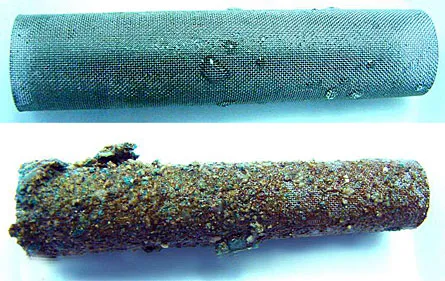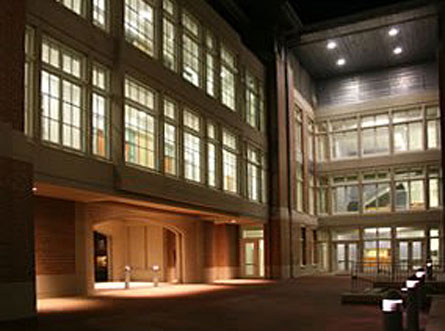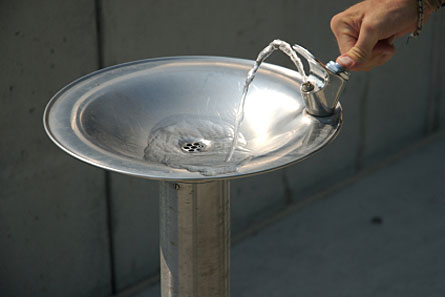Lead-free? Faucets are anything but
Some faucets are exempt from all lead standards. Read more.



Caroline Elfland began receiving complaints soon after researchers started occupying one of a pair of brand new buildings on the University of North Carolina campus, almost two years ago. People said the water tasted funny — as in bad. To ferret out the source of the noxious taste, this associate vice chancellor directed all sorts of probes into the new facilities’ construction, into water entering the buildings from mains in the street, and of course into plumbing materials.
Within several months, these investigations uncovered a nasty surprise — one that would ultimately prove unrelated to the taste problem. Faucets throughout both buildings in the $100 million science complex — along with those in an equally new building elsewhere on campus — were dispensing water heavily contaminated with lead, a toxic heavy metal.
“These were brand new buildings,” Elfland emphasizes. “They had no lead solder. No lead pipes. How could this be?” The water utility couldn’t be blamed; its supplies were lead-free.
The investigations Elfland triggered would ultimately indict new “lead-free” faucets. These weren’t weird faucets. Or foreign counterfeit fixtures. Or in any way unusual. They’re the same types and brands of faucets used throughout American homes, businesses and schools.
Elfland is coauthoring a paper describing this nightmarish case study for an American Water Works Association specialty conference in about two weeks.
The Environmental Protection Agency requires that action be taken to reduce lead in drinking water when concentrations reach 15 parts per billion. Values associated with every tap in the new UNC buildings exceeded that. Sometimes by a factor of 10. In the worst case: Drinking water carried 1,200 ppb lead.
As word got out, Elfland recalls people were starting to panic. “I had pregnant post-doctoral fellows asking me: ‘Have I been drinking lead in water?’”
Eager to get to the heart of the problem, Elfland asked her school’s engineering faculty for guidance. And they said: “We have two words for you — Marc Edwards.” The Virginia Tech engineering professor has a reputation for solving challenging water-quality puzzles.
That was 18 months ago.
Edwards quickly traced the problem to the buildings’ faucets and water fountains. Or, more precisely, to the fixtures’ brass.
Commercial and almost all home drinking-water fixtures are made from brass, even if they carry a plated veneer of chrome, nickel or brushed aluminum. In the United States, that brass can contain up to 8 percent lead — as long as it doesn’t leach more than 11 ppb of the metal into drinking water.
The problem, Edwards — and now UNC — has found: The standard recipe for the water used to evaluate how much lead will leach from a brass fixture is remarkably tame. Think of it as crash testing a car by running it into a pile of pillows. Of course it won’t sustain damage. Contends Edwards, the water that the plumbing industry uses to evaluate lead leaching similarly offers an easy test for most brass fixtures to pass.
In the real world, however, as in UNC’s new research buildings, these fixtures can fail the lead-leaching test. Big time.
The good news: Serious lead leaching doesn’t tend to continue forever. Over time, the brass tends to develop a sheath of rust and chemicals that will retard the toxic metal’s escape. How long it takes for the leach-inhibiting coating to develop depends on the recipe of the local water and the lead content of the fixtures.
In UNC’s case, the water had a low concentration of sodium-bicarbonate (what we know of as baking soda). And that’s too bad, since that bicarbonate would have helped to quickly coat the brass surface. The local water was also disinfected with chloramine, not chlorine. Another problem since chlorine tends to retard lead leaching, Edwards says. For reasons that have yet to emerge, he notes, chloramine-treated water doesn’t.
So is there something anomalous about water serving the Chapel Hill, N.C., campus? Not really, Edwards says. “We’re not seeing this more because we haven’t been looking.” People seldom test for lead in new buildings. “If they did,” he told me, “I think they’d find it in a surprising number of locations.”
Based on the specific chemical makeup of UNC’s water, lead-leaching from new faucets normally takes about six months to naturally abate, Elfland found.
Edwards designed a simple means to accelerate the process. Run every faucet in a new building at full throttle for 10 minutes, then crank the flow rate down to a trickle and let the water continue running from every faucet for the next three days. Following this conditioning protocol, 99 percent of UNC’s new faucets met the EPA lead standard.
While effective, this procedure proved time consuming and costly. Water had to be sampled from every fixture, and then sent to an EPA-certified lab for testing. “In round numbers,” Elfland has calculated, “this comes to about $100 a tap.”
And that’s not the end of it. Aerators and sieves collect debris at the end of a faucet or right inside the top of the fountains. And surprisingly, Edwards found at UNC, much of that debris consists of lead. Indeed, some collectors accumulated astounding amounts of corrosion debris and lead after just the conditioning treatments.
So each treated fixture must to be opened and cleaned out. If you don’t do that, Elfland warns, the exiting water will just wash over those particles — grinding them down (and into your water glass) or just leaching out much of their lead. This could cause the lead-poisoning risk to persist months or more after the fixtures’ brass has all but shut down its leaching.
“If I could find a faucet or water fountain made with no lead, even if it cost $50 more per faucet, I’d buy them,” Elfland says. In the end, they’d cost her less.
So, I asked her, have you identified such faucets? “Uh, no,” she says. And she’s looked — high and low. For more on the depressing information she and Edwards turned up during that search, check back for tomorrow’s blog.





